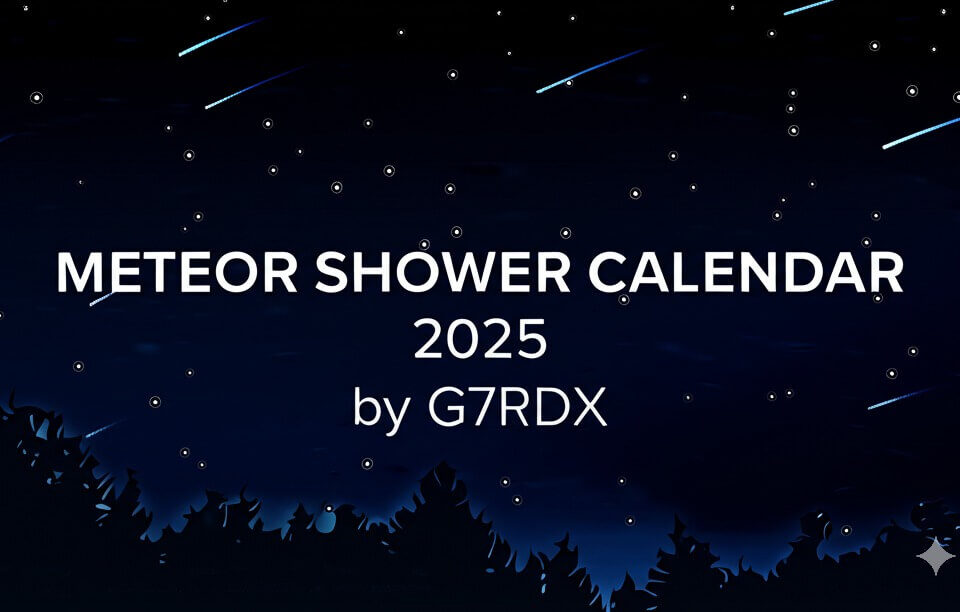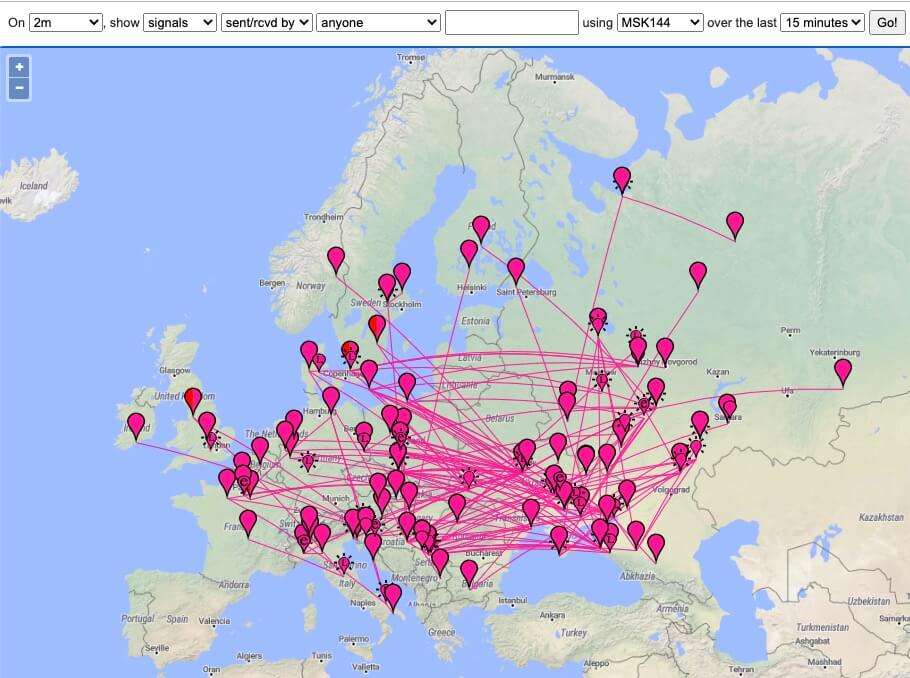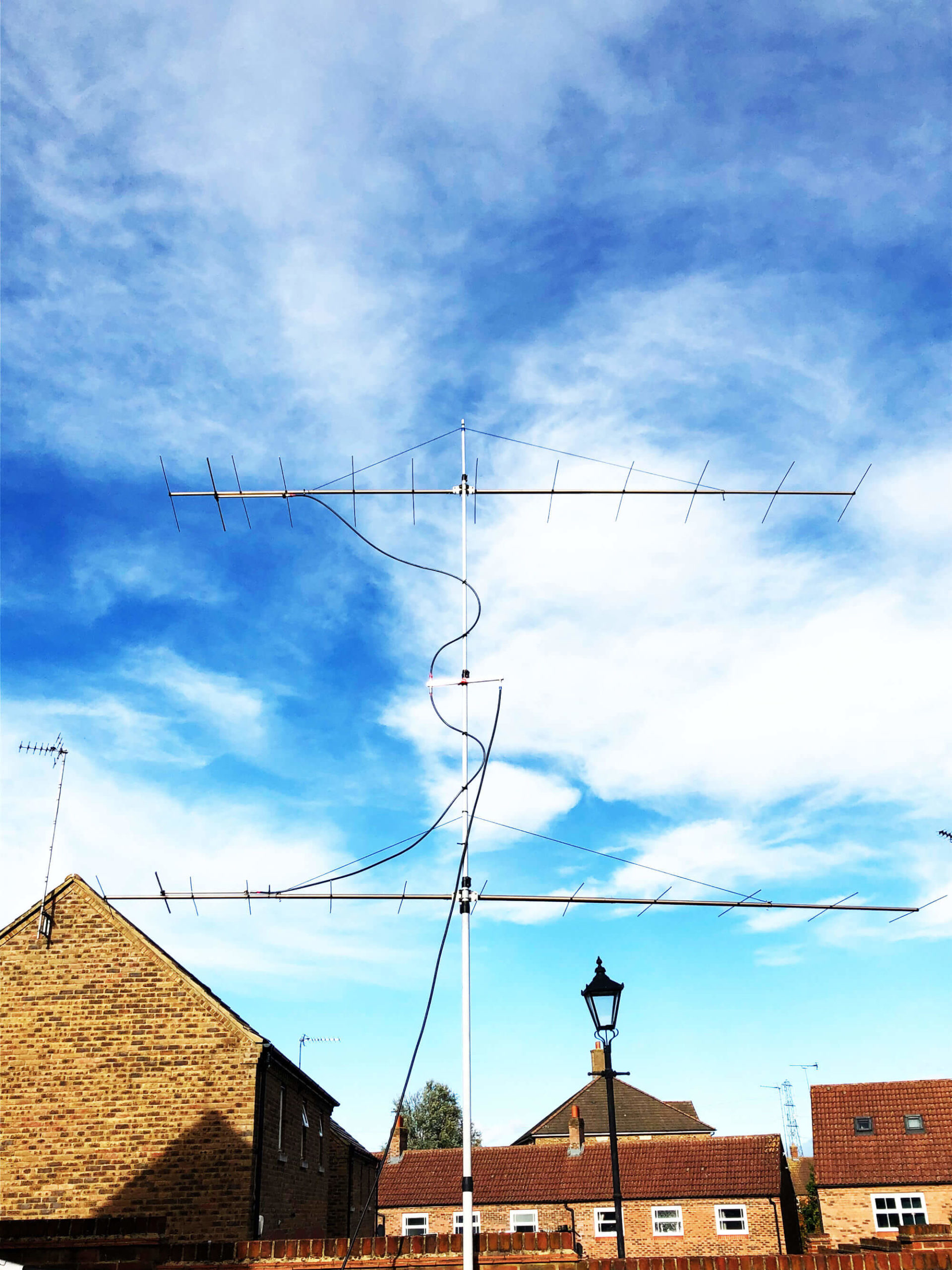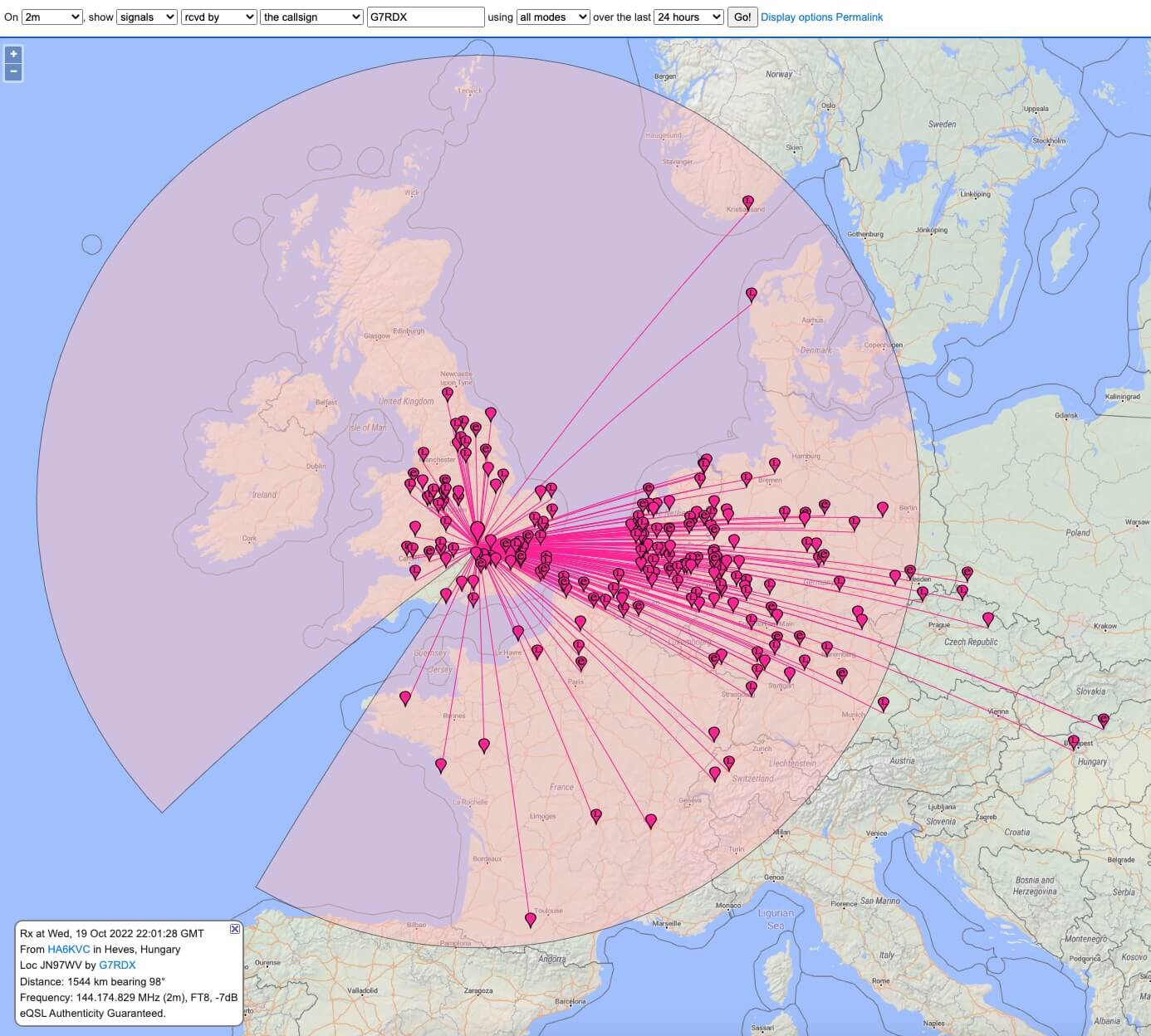Table of Contents
Meteor Shower Peaks 2025
Updated Meteor Shower Calendar 2025-2026 for Amateur Radio
VHF enthusiasts use meteor scatter to make contacts over distances up to 2000 km. With several major meteor shower events throughout the year, this calendar will help you prepare to take advantage of these celestial events for radio communications.
Below is a table summarising the meteor showers in 2025-2026, including their activity dates, peak dates, and ZHRs:
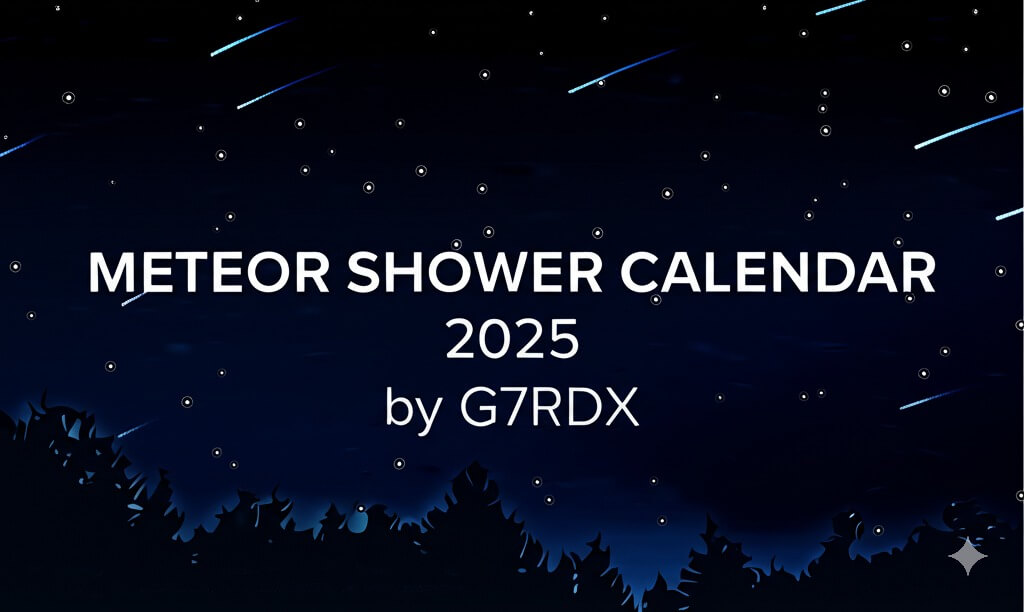
Meteor Shower Peaks 2025-2026
| Meteor Shower | Activity Dates | Peak Dates | ZHR | Description |
|---|---|---|---|---|
| Quadrantids | Dec 26, 2025 – Jan 16, 2026 | Jan 3-4, 2026 | 120 | Bluish or yellowish-white meteors with fine trains. Bright fast meteors, potential for fireballs. The peak is very narrow (about 6 hours). Moonlight conditions: Full moon will severely impact visibility in 2026. |
| Lyrids | Apr 16-25, 2025 | Apr 21-22, 2025 | 18 | Bright fast meteors, some with trains. Associated with Comet Thatcher. Moonlight conditions: 40% moon illumination – reasonably good viewing conditions. |
| Eta Aquariids | Apr 19 – May 28, 2025 | May 5-6, 2025 | 50 | Swift meteors (66 km/sec), with fine persistent trains. Associated with Comet Halley. Best seen from southern hemisphere, but still visible in north before dawn. Moonlight conditions: 64% moon illumination – moderate interference. |
| Delta Aquariids | Jul 12 – Aug 23, 2025 | Jul 29-30, 2025 | 25 | Medium speed meteors (40 km/sec). Best viewed from southern hemisphere, moderate rates in northern hemisphere. Moonlight conditions: 27% moon illumination – good viewing conditions. |
| Alpha Capricornids | Jul 3 – Aug 15, 2025 | Jul 30, 2025 | 5 | Slow bright yellow fireballs. Equally visible from both hemispheres. While rates are low, this shower is known for producing bright fireballs. Moonlight conditions: 27% moon illumination – good viewing conditions. |
| Perseids | Jul 17 – Aug 24, 2025 | Aug 12-13, 2025 | 100 | Many bright fast meteors with trains. Associated with Comet Swift-Tuttle. Best summer shower for northern hemisphere. Moonlight conditions: 84% moon illumination – substantial interference. |
| Draconids | Oct 6-10, 2025 | Oct 8-9, 2025 | 10 | Slow meteors. Associated with Comet 21P/Giacobini-Zimmer. Unusual in that it’s best seen in the evening rather than morning hours. |
| Orionids | Oct 2 – Nov 7, 2025 | Oct 21-22, 2025 | 20 | Fast with fine trains. Associated with Comet Halley. Moonlight conditions: 2% moon illumination – excellent viewing conditions. |
| Southern Taurids | Sep 10 – Nov 20, 2025 | Nov 4-5, 2025 | 5 | Very slow meteors. 2025 is a swarm year, potentially producing more bright fireballs. Moonlight conditions: 96% moon illumination – poor viewing conditions. |
| Northern Taurids | Oct 20 – Dec 10, 2025 | Nov 11-12, 2025 | 5 | Very slow meteors. Associated with Comet Encke. Moonlight conditions: 83% moon illumination – poor viewing conditions. |
| Leonids | Nov 6-30, 2025 | Nov 16-17, 2025 | 15 | Very fast meteors (71 km/sec) with persistent trains. Associated with Comet Tempel-Tuttle. Moonlight conditions: 9% moon illumination – excellent viewing conditions. |
| Geminids | Dec 4-17, 2025 | Dec 13-14, 2025 | 120 | Plenty of bright meteors, few trains. Associated with asteroid 3200 Phaethon. Often the most reliable shower of the year. Moonlight conditions: 39% moon illumination – reasonably good viewing conditions. |
| Ursids | Dec 17-26, 2025 | Dec 21-22, 2025 | 10 | Sparse shower. Associated with comet 8P/Tuttle. Moonlight conditions: 3% moon illumination – excellent viewing conditions. |
KST Chat for VHF/UHF/SHF Skeds
For coordinating meteor scatter contacts: http://www.on4kst.com/chat/start.php
Meteor Showers Live
To monitor meteor activity in real-time: https://www.meteorscan.com/meteor-live.html
Detailed Information on Major Meteor Showers
Quadrantids: January 3-4, 2026 (ZHR 120)
The Quadrantids meteor shower is active from December 26 to January 16, with its peak on the night of January 3-4. This shower is known for producing bright, fast-moving meteors with the potential for impressive fireballs, making it a great target for radio detection.
Amateur radio operators can listen for reflections of the signals they transmit off of the ionised trails left behind by these meteors. The ZHR for the Quadrantids is 120, which means that under ideal conditions, observers can expect to see 120 meteors per hour.
Due to the high northerly declination (celestial latitude), these meteors are not well seen from the southern hemisphere. Predictions for 2026 show a peak near 00:36 UT on January 4th. Unfortunately, activity will be severely compromised in 2026 as a full moon occurs on January 3rd, which will obscure all but the brightest meteors.
Lyrids: April 21-22, 2025 (ZHR 18)
Active from April 16-25, with its peak on the night of April 21-22, the Lyrids meteor shower is caused by debris from Comet Thatcher. This shower produces relatively bright, fast meteors, many with persistent trains making them excellent for meteor scatter radio work.
Radio operators can listen for reflections of their signals off of the ionized trails created by these meteors. The ZHR for the Lyrids is 18, which means that observers can expect to see around 18 meteors per hour under ideal conditions. The waning crescent moon will be 40% illuminated, allowing for reasonably good viewing conditions in 2025.
Eta Aquariids: May 5-6, 2025 (ZHR 50)
The Eta Aquariids meteor shower is active from April 19 to May 28, with its peak on the night of May 5-6. This shower is caused by debris from Halley’s Comet and produces fast-moving meteors that are excellent for meteor scatter.
These meteors are swift (66 km/sec) and often leave persistent trains ideal for radio reflections. The ZHR for the Eta Aquariids is 50, which means you could expect around 50 meteors per hour under perfect conditions in the southern hemisphere, and about 10-30 in the northern hemisphere.
In 2025, a 64% illuminated moon will cause moderate interference, but the shower should still provide good opportunities for meteor scatter work, especially in the pre-dawn hours.
Perseids: August 12-13, 2025 (ZHR 100)
One of the most popular meteor showers of the year, the Perseids are active from July 17 to August 24, with their peak on the night of August 12-13. This shower produces bright, fast-moving meteors that can be easily detected via radio.
The Perseids are particles released from comet 109P/Swift-Tuttle during its numerous returns to the inner solar system. Amateur radio operators can listen for reflections of their signals off of the ionized trails created by these meteors. The ZHR for the Perseids is 100, which means that observers can expect to see around 100 meteors per hour under ideal conditions.
In 2025, the waning gibbous moon will be 84% illuminated, which will substantially reduce the number of visible meteors. However, radio detection should still be effective as the ionization trails are not affected by moonlight.
Orionids: October 21-22, 2025 (ZHR 20)
Active from October 2 to November 7, with its peak on the night of October 21-22, the Orionids meteor shower is caused by debris from Halley’s Comet. This shower produces relatively fast-moving meteors that can be effectively detected via radio.
Amateur radio operators can listen for reflections of their signals off of the ionized trails created by these meteors. The ZHR for the Orionids is 20, which means that observers can expect to see around 20 meteors per hour under ideal conditions.
The 2025 Orionids will be particularly favorable for observation as the moon will be only 2% illuminated, providing excellent dark sky conditions.
Leonids: November 16-17, 2025 (ZHR 15)
The Leonids meteor shower is caused by debris from Comet Tempel-Tuttle. This shower produces fast-moving meteors that can be challenging to detect via radio, but they are often bright and colorful with persistent trails.
Amateur radio operators can listen for reflections of their signals off of the ionised trails created by these meteors. The ZHR for the Leonids is 15, which means that observers can expect to see around 15 meteors per hour under ideal conditions.
In 2025, the moon will be only 9% illuminated, providing excellent dark sky conditions for both visual and radio observation.
Geminids: December 13-14, 2025 (ZHR 120)
The Geminids meteor shower is caused by debris from the asteroid 3200 Phaethon, and produces a high number of meteors per hour. This is one of the few major showers not originating from a comet. Amateur radio operators can listen for reflections of their signals off of the ionised trails created by these meteors.
The ZHR for the Geminids is 120, which means that observers can expect to see around 120 meteors per hour under ideal conditions. This shower is often the most reliable of the year, with numerous bright, medium-speed meteors.
In 2025, the moon will be 39% illuminated, providing reasonably good viewing conditions. The Geminids are also unique among meteor showers as they provide good activity before midnight, as the constellation Gemini is well placed from 22:00 onward.
Meteor Scatter for Amateur Radio
Meteor scatter is an exciting propagation mode that allows VHF operators to make contacts over distances that would normally be impossible using tropospheric propagation. As meteors enter the Earth’s atmosphere, they create ionized trails that can reflect radio signals. These ionized trails typically last from a fraction of a second to several seconds, though larger meteors can create trails that persist for a minute or more.
The best frequencies for meteor scatter are typically in the 50 MHz (6 meters) and 144 MHz (2 meters) bands. Digital modes like MSK144, which is part of the WSJT-X software suite, are particularly effective for meteor scatter communications due to their ability to decode signals from very brief meteor bursts.
For effective meteor scatter operation:
- Plan your activity during peak shower times listed in this calendar
- Focus efforts during early morning hours when meteor rates are typically higher
- Use appropriate digital modes like MSK144
- Coordinate with potential contacts via KST chat or other coordination channels
- Be patient – meteor scatter contacts often require persistence
Meteor scatter provides an excellent opportunity for VHF enthusiasts to make contacts over impressive distances and is a fascinating blend of astronomy and radio technology.
Useful Websites for Meteor Information
- International Meteor Organization (IMO): Comprehensive meteor shower information and reports.
- American Meteor Society: Detailed meteor shower data and current activity.
- Royal Observatory Greenwich: Monthly sky guides and meteor shower information.
- ARRL – Meteor Scatter: Ham radio information specific to meteor scatter communications.
- WSJT-X Software: Essential software for digital meteor scatter communications.
Happy meteor scatter hunting!
